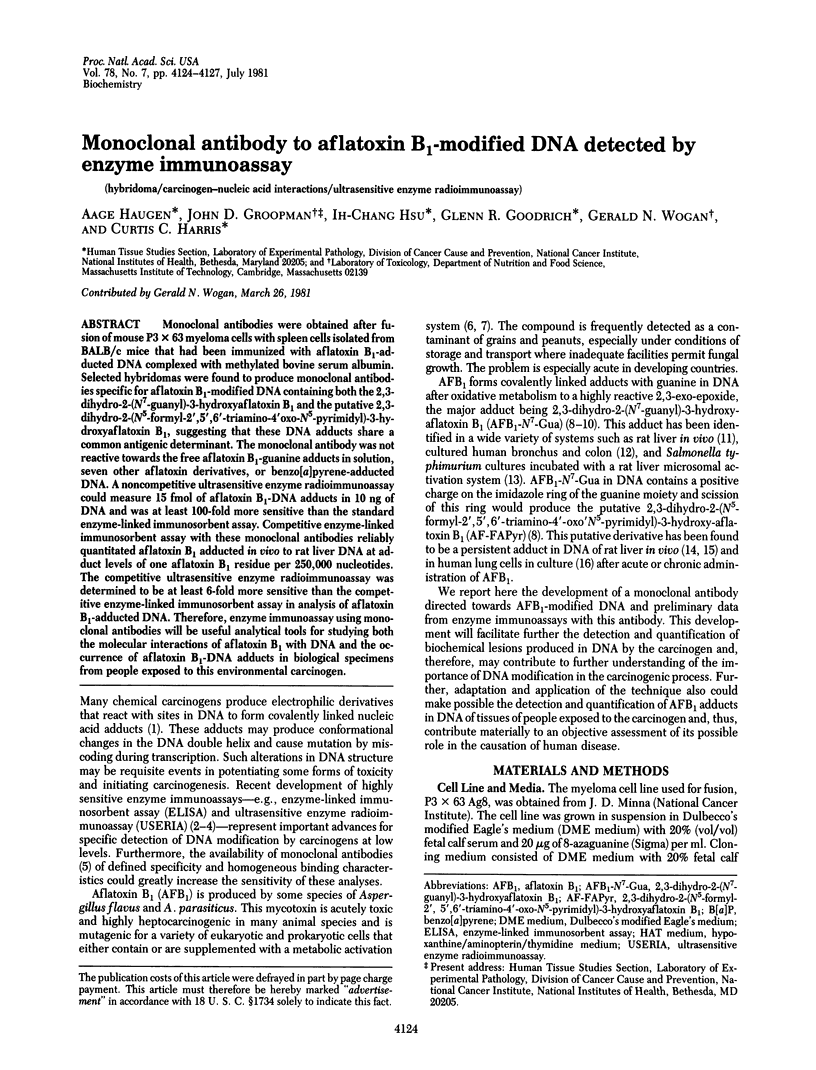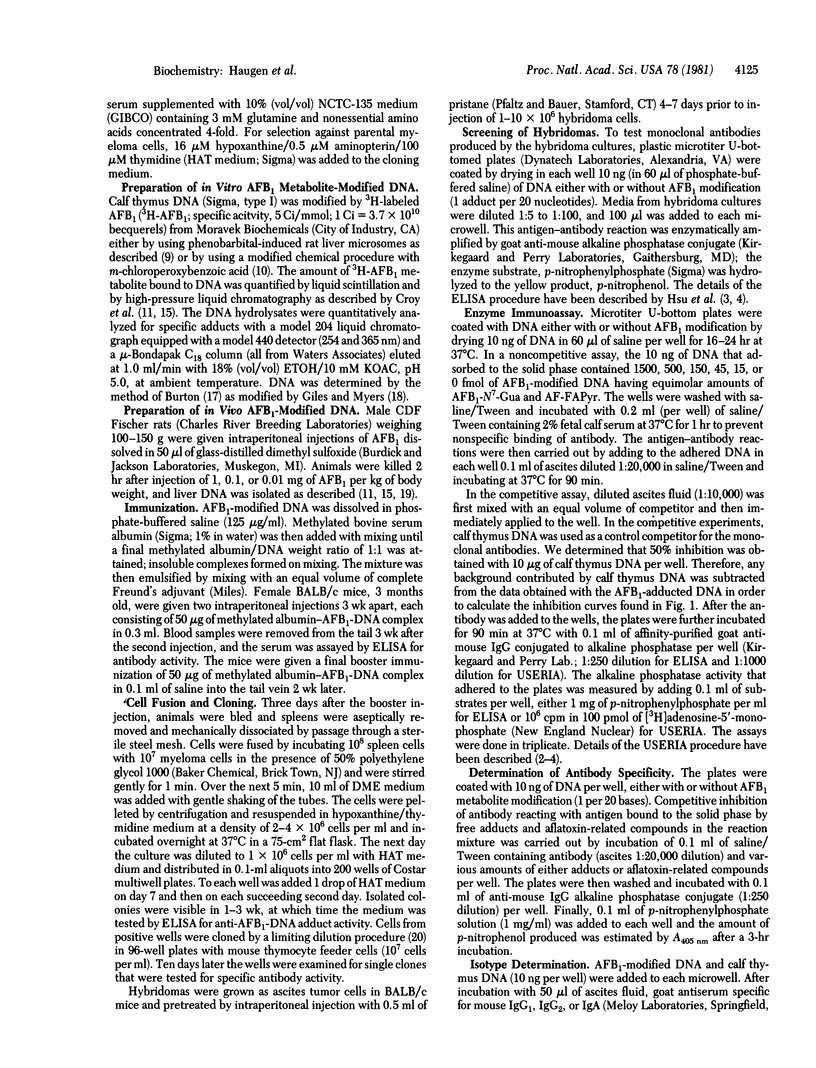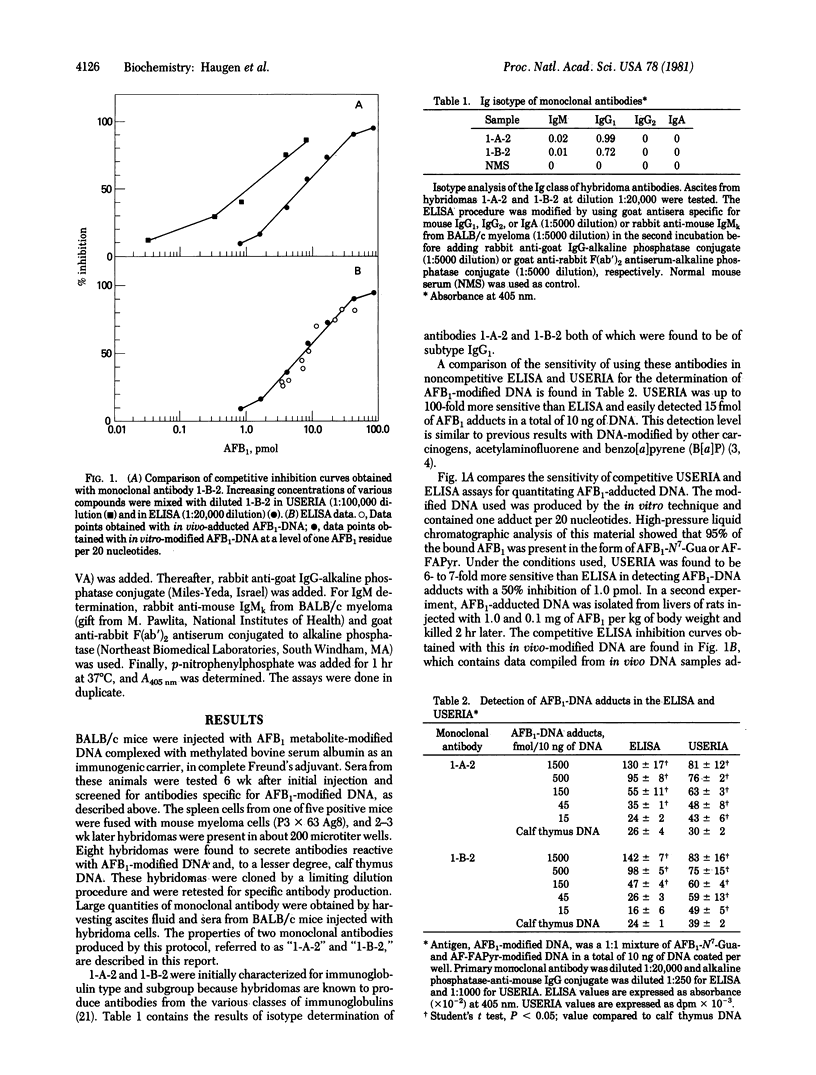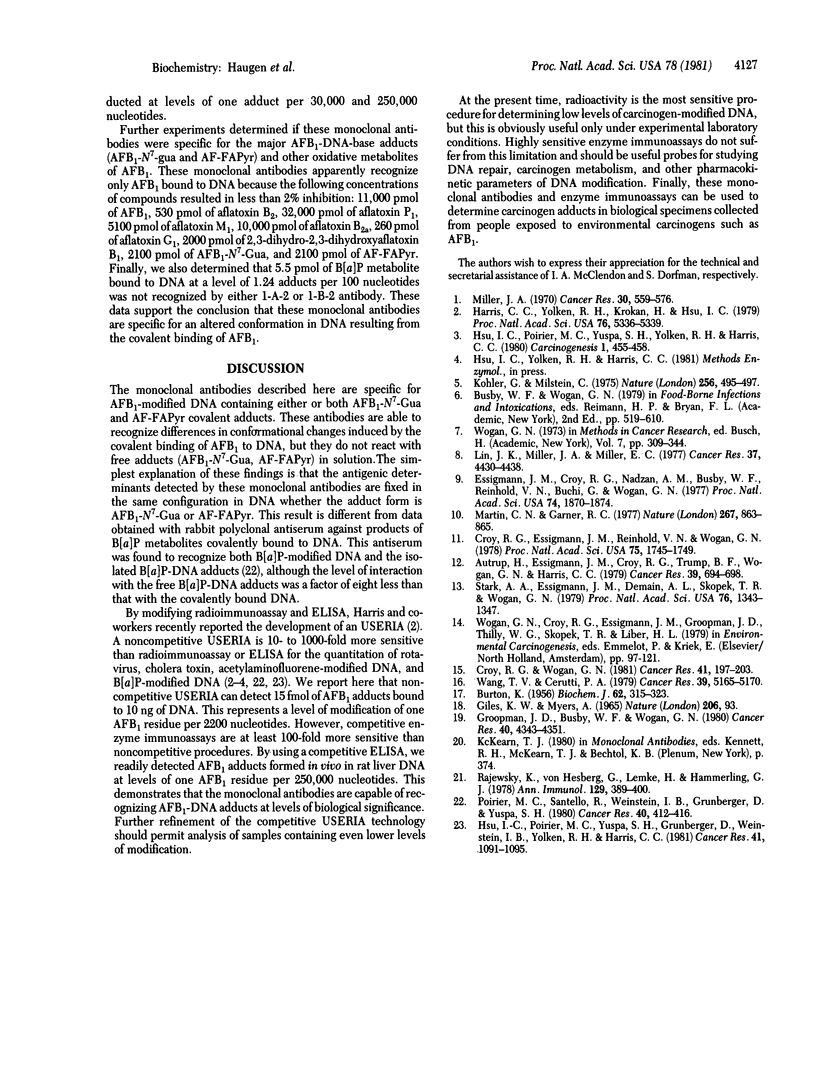Abstract
Monoclonal antibodies were obtained after fusion of mouse P3 X 63 myeloma cells with spleen cells isolated from BALB/c mice that had been immunized with aflatoxin B1-adducted DNA complexed with methylated bovine serum albumin. Selected hybridomas were found to produce monoclonal antibodies specific for aflatoxin B1-modified DNA containing both the 2,3-dihydro-2-(N7-guanyl)-3-hydroxyaflatoxin B1 and the putative 2,3-dihydro-2-(N5-formyl-2',5',6'-triamino-4'oxo-N5-pyrimidyl) -3-hydroxyaflatoxin B1, suggesting that these DNA adducts share a common antigenic determinant. The monoclonal antibody was not reactive towards the free aflatoxin B1-guanine adducts in solution, seven other aflatoxin derivatives, or benzo[a]pyrene-adducted DNA. A noncompetitive ultrasensitive enzyme radioimmunoassay could measure 15 fmol of aflatoxin B1-DNA adducts in 10 ng of DNA and was at least 100-fold more sensitive than the standard enzyme-linked immunosorbent assay. Competitive enzyme-linked immunosorbent assay with these monoclonal antibodies reliably quantitated aflatoxin B1 adducted in vivo to rat liver DNA at adduct levels of one aflatoxin B1 residue per 250,000 nucleotides. The competitive ultrasensitive enzyme radioimmunoassay was determined to be at least 6-fold more sensitive than the competitive enzyme-linked immunosorbent assay in analysis of aflatoxin B1-adducted DNA. Therefore, enzyme immunoassay using monoclonal antibodies will be useful analytical tools for studying both the molecular interactions of aflatoxin B1 with DNA and the occurrence of aflatoxin B1-DNA adducts in biological specimens from people exposed to this environmental carcinogen.
Full text
PDF



Selected References
These references are in PubMed. This may not be the complete list of references from this article.
- Autrup H., Essigmann J. M., Croy R. G., Trump B. F., Wogan G. N., Harris C. C. Metabolism of aflatoxin B1 and identification of the major aflatoxin B1-DNA adducts formed in cultured human bronchus and colon. Cancer Res. 1979 Mar;39(3):694–698. [PubMed] [Google Scholar]
- BURTON K. A study of the conditions and mechanism of the diphenylamine reaction for the colorimetric estimation of deoxyribonucleic acid. Biochem J. 1956 Feb;62(2):315–323. doi: 10.1042/bj0620315. [DOI] [PMC free article] [PubMed] [Google Scholar]
- Croy R. G., Essigmann J. M., Reinhold V. N., Wogan G. N. Identification of the principal aflatoxin B1-DNA adduct formed in vivo in rat liver. Proc Natl Acad Sci U S A. 1978 Apr;75(4):1745–1749. doi: 10.1073/pnas.75.4.1745. [DOI] [PMC free article] [PubMed] [Google Scholar]
- Croy R. G., Wogan G. N. Temporal patterns of covalent DNA adducts in rat liver after single and multiple doses of aflatoxin B1. Cancer Res. 1981 Jan;41(1):197–203. [PubMed] [Google Scholar]
- Essigmann J. M., Croy R. G., Nadzan A. M., Busby W. F., Jr, Reinhold V. N., Büchi G., Wogan G. N. Structural identification of the major DNA adduct formed by aflatoxin B1 in vitro. Proc Natl Acad Sci U S A. 1977 May;74(5):1870–1874. doi: 10.1073/pnas.74.5.1870. [DOI] [PMC free article] [PubMed] [Google Scholar]
- Groopman J. D., Busby W. F., Jr, Wogan G. N. Nuclear distribution of aflatoxin B1 and its interaction with histones in rat liver in vivo. Cancer Res. 1980 Dec;40(12):4343–4351. [PubMed] [Google Scholar]
- Harris C. C., Yolken R. H., Krokan H., Hsu I. C. Ultrasensitive enzymatic radioimmunoassay: application to detection of cholera toxin and rotavirus. Proc Natl Acad Sci U S A. 1979 Oct;76(10):5336–5339. doi: 10.1073/pnas.76.10.5336. [DOI] [PMC free article] [PubMed] [Google Scholar]
- Hsu I. C., Poirier M. C., Yuspa S. H., Grunberger D., Weinstein I. B., Yolken R. H., Harris C. C. Measurement of benzo(a)pyrene-DNA adducts by enzyme immunoassays and radioimmunoassay. Cancer Res. 1981 Mar;41(3):1091–1095. [PubMed] [Google Scholar]
- Hsu I. C., Poirier M. C., Yuspa S. H., Yolken R. H., Harris C. C. Ultrasensitive enzymatic radioimmunoassay (USERIA) detects femtomoles of acetylaminofluorene-DNA adducts. Carcinogenesis. 1980 May;1(5):455–458. doi: 10.1093/carcin/1.5.455. [DOI] [PubMed] [Google Scholar]
- Köhler G., Milstein C. Continuous cultures of fused cells secreting antibody of predefined specificity. Nature. 1975 Aug 7;256(5517):495–497. doi: 10.1038/256495a0. [DOI] [PubMed] [Google Scholar]
- Lin J. K., Miller J. A., Miller E. C. 2,3-Dihydro-2-(guan-7-yl)-3-hydroxy-aflatoxin B1, a major acid hydrolysis product of aflatoxin B1-DNA or -ribosomal RNA adducts formed in hepatic microsome-mediated reactions and in rat liver in vivo. Cancer Res. 1977 Dec;37(12):4430–4438. [PubMed] [Google Scholar]
- MASTER R. W. POSSIBLE SYNTHESIS OF POLYRIBONUCLEOTIDES OF KNOWN BASE-TRIPLET SEQUENCES. Nature. 1965 Apr 3;206:93–93. doi: 10.1038/206093b0. [DOI] [PubMed] [Google Scholar]
- Martin C. N., Garner R. C. Aflatoxin B -oxide generated by chemical or enzymic oxidation of aflatoxin B1 causes guanine substitution in nucleic acids. Nature. 1977 Jun 30;267(5614):863–865. doi: 10.1038/267863a0. [DOI] [PubMed] [Google Scholar]
- Miller J. A. Carcinogenesis by chemicals: an overview--G. H. A. Clowes memorial lecture. Cancer Res. 1970 Mar;30(3):559–576. [PubMed] [Google Scholar]
- Poirier M. C., Santella R., Weinstein I. B., Grunberger D., Yuspa S. H. Quantitation of benzo(a)pyrene-deoxyguanosine adducts by radioimmunoassay. Cancer Res. 1980 Feb;40(2):412–416. [PubMed] [Google Scholar]
- Stark A. A., Essigmann J. M., Demain A. L., Skopek T. R., Wogan G. N. Aflatoxin B1 mutagenesis, DNA binding, and adduct formation in Salmonella typhimurium. Proc Natl Acad Sci U S A. 1979 Mar;76(3):1343–1347. doi: 10.1073/pnas.76.3.1343. [DOI] [PMC free article] [PubMed] [Google Scholar]
- Wang T. C., Cerutti P. A. Formation and removal of aflatoxin B1-induced DNA lesions in epithelioid human lung cells. Cancer Res. 1979 Dec;39(12):5165–5170. [PubMed] [Google Scholar]


